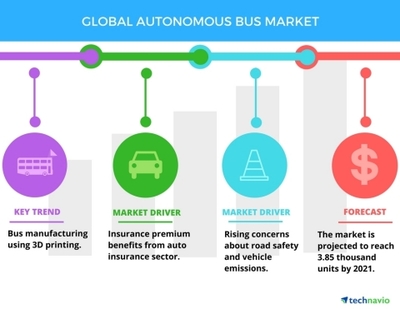Autonomous Bus Market - Drivers and Forecasts by Technavio
LONDON—Technavio analysts forecast the global autonomous bus market to grow at a CAGR of almost 38% during the forecast period, according to their latest report.
The research study covers the present scenario and growth prospects of the global autonomous bus market for 2017-2021. The market is segmented based on geography, including North America, Europe, and APAC.
The increasing traffic congestion, inducing people to adopt shared mobility services is the major reason behind increased developments in the autonomous bus and taxi markets rather than the passenger car market. Another factor is the ease of development of autonomous vehicles as they will travel in a definite route or region facing almost 88% of regular conditions and driving tasks. This is one of the major reasons why many of the OEMs are not pushing many developments into autonomous vehicles of the passenger car segment, and new entries, such as Google, Baidu, Zoox, BestMile, etc. are going to occupy a major share in the shared autonomous mobility.
This report is available at a USD 1,000 discount for a limited time only: View market snapshot before purchasing
Buy 1 Technavio report and get the second for 50% off. Buy 2 Technavio reports and get the third for free.
Technavio automotive research analysts highlight the following three factors that are contributing to the growth of the global autonomous bus market:
- Insurance premium benefits from auto insurance sector
- Increased adoption of ADAS in vehicles pushing to level 2 autonomous and above
- Rising concerns about road safety and vehicle emissions
Looking for more information on this market? Request a free sample report
Technavio’s sample reports are free of charge and contain multiple sections of the report including the market size and forecast, drivers, challenges, trends, and more.
Insurance premium benefits from auto insurance sector
Autonomous technology involving the higher adoption of ADAS is expected to bring down the on-road vehicle-related fatalities globally, depending on the regional adoption rates. Auto-insurance companies are expected to support such initiatives owing to the financial benefits.
Neelam Barua, a lead automotive manufacturing research analyst at Technavio, says, “The primary benefit for insurance companies is in the form of reduced claims for on-road fatalities because of a net reduction in the occurrence of road accidents globally. As per the industry experts, it is believed that auto emergency braking, adaptive cruise control, and other ADAS technologies can help in reducing insurance claims by as much as 40%. This, in turn, can bring monetary profits for the insurance companies.”
Increased adoption of ADAS in vehicles pushing them to level 2 autonomous and above
Advanced driver assistance systems (ADAS) adoption is the major solution to achieve level 2 and above autonomous vehicles. The number of features provided by ADAS has been increasing over the years, and the system has evolved into a robust and reliable one. In the past years, ADAS was implemented only in premium vehicles due to its high cost. However, due to technological advancement and expansion of ADAS ecology, OEMs are introducing this system even in economy level vehicles. This will augment the growth of the global autonomous bus market during the forecast period.
“ADAS SoCs are the future of safety systems. They can be integrated with various sensory inputs like camera, LiDAR, radar, infrared, and ultrasonic. The SoCs can house multiple CPU cores, signal processors, and graphic processing units and are quite efficient in handling real-time data in multiplicity. Thus, vehicle manufacturers will have increased flexibility and control over their ADAS portfolio,” adds Neelam.
Rising concerns about road safety and vehicle emissions
Human errors cause more than 80% of the road fatalities; automated vehicles will help in curbing such fatalities significantly. The increasing number of road fatalities is, in turn, building up the high cost for fleet operators for the accident claims.
The growing concerns about greenhouse gas (GHG) emissions are pushing governments across the globe to focus on alternative fuel vehicle or new energy vehicles. A lot of emphasis has been directed toward the transportation sector because it consumes huge volumes of fuel. The transportation sector is the second largest GHG emissions contributor, and this calls for aggressive steps to curb such emissions.
Top vendors:
- Dailmer
- EasyMile
- Proterra
- Yutong
Browse Related Reports:
- Global ATV Market 2017-2021
- Global Automotive 3D Printing Market 2017-2021
- Global Agricultural Tractor Market 2017-2021
About Technavio
Technavio is a leading global technology research and advisory company. Their research and analysis focuses on emerging market trends and provides actionable insights to help businesses identify market opportunities and develop effective strategies to optimize their market positions.
With over 500 specialized analysts, Technavio’s report library consists of more than 10,000 reports and counting, covering 800 technologies, spanning across 50 countries. Their client base consists of enterprises of all sizes, including more than 100 Fortune 500 companies. This growing client base relies on Technavio’s comprehensive coverage, extensive research, and actionable market insights to identify opportunities in existing and potential markets and assess their competitive positions within changing market scenarios.



